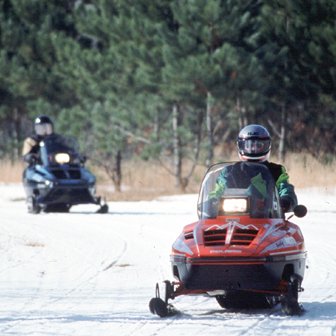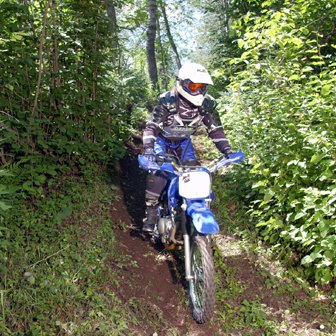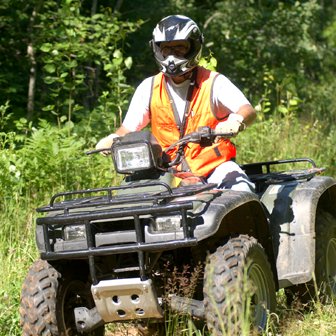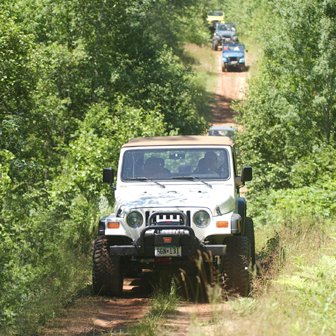January 8, 2003
 Major
Findings:
Major
Findings:
Key Recommendations:
 Report
Summary
Report
Summary
Motorized recreation on Minnesota's trails is a hotly debated topic with skeptics and enthusiasts disagreeing about the impact that snowmobiles and off-highway vehicles (OHVs) have on the environment and about the size and nature of the trail systems that the state should have. (OHVs include all-terrain vehicles (ATVs), dirt bikes, and 4X4 trucks.) In light of this debate, the Legislative Audit Commission directed our office to evaluate the state's current system of designated trails for motorized recreation that receive state funding. In fiscal year 2002, DNR committed $9 million to snowmobile trails and $3 million to OHV trails.
This report addresses (1) the size of the current trail systems for snowmobiles and OHVs, (2) the efforts of DNR to plan these trail systems, (3) the efforts of DNR to enforce laws and rules concerning the operation of snowmobiles and OHVs, (4) the oversight received by local clubs that use DNR grants-in-aid to develop and maintain trails, and (5) the funding of trails. Overall, we found that while DNR's management of snowmobile trails has served Minnesota relatively well, the department needs to improve its management of OHVs.
Minnesota Has an Expansive Trail System for Snowmobiles but a More Limited System for OHVs
Minnesota has 18,941 miles of designated snowmobile trails. While the state has only 953 miles of designated OHV trails, OHVs can use roughly 6,000 miles of undesignated trails in state forests and another 1,600 miles of forest roads.<FN - The miles of designated trails were estimated as of November 2002. These numbers may increase as DNR finishes bringing in snowmobile trails that the 2002 Legislature authorized for the grant-in-aid program and as OHV trails in the development pipeline are completed.> In addition, snowmobiles and ATVs can ride in the ditches of thousands of miles of highway right-of-ways throughout the state. <FN - ATVs cannot ride in the ditches in the state's "agricultural zone," which is the southern half of the state, from April 1 through August 1.> Despite thousands of miles of riding opportunities, OHV enthusiasts want DNR to officially designate more miles of trail for OHVs because the undesignated trails do not have signs, are not mapped, and are harder to identify and navigate than the designated trails. Local clubs that receive grants-in-aid from DNR administer 91 percent of the state's designated trail miles for snowmobiles and 85 percent of the designated trail miles for OHVs.
 DNR's
Effort to Plan a Statewide OHV Trail System Has Been Inadequate
DNR's
Effort to Plan a Statewide OHV Trail System Has Been Inadequate
Despite acknowledging the need toplan for and manage OHVs as early as the mid-1970s, DNR delayed initiating a formal planning process until the Legislature required action in 1993. Once the department started planning in 1996, the process lacked (1) complete information about the recreational needs of OHV riders, (2) a thorough examination of environmental factors, and (3) fiscal information about how much it would cost to annually develop, administer, maintain, and enforce the OHV trails in the plans. These three areas—community needs, environmental protection, and economic/fiscal considerations—are, in fact, DNR's own standards for good natural resources planning. <FN - Department of Natural Resources, Directions 2000: The Strategic Plan (St. Paul, September 2000), 2-7. With respect to economic considerations, this document primarily focuses on economic development (e.g. tourism and logging). However, it also discusses fiscal responsibility. In addition, according to DNR's regional planners, fiscal responsibility is a key element of natural resources planning.> In the last year or two, DNR has rearticulated its policy concerning OHVs, with an emphasis on "managed use on managed trails." It is too early to determine if these changes will be sufficient to overcome the planning shortcomings that have occurred so far.
In contrast, DNR's trail planning for snowmobiles has been less formal and systematic. Snowmobile clubs have largely determined if and where trails are built with limited direction from DNR. <FN - With respect to trails on state land, DNR played a role in deciding where and how trails were developed.> Despite this lack of formal and systematic planning, snowmobiles have gained a level of acceptance in Minnesota and contributed millions of tourism dollars to the state's economy. There is a general consensus that snowmobiles have a smaller overall impact on the environment than OHVs.
OHV Enforcement Has Not Received Sufficient Resources
In the last five years, on a per vehicle basis, DNR has spent 26 percent less time enforcing laws and rules related to OHVs than those related to snowmobiles. This occurred despite the fact that OHVs generally have a greater impact on the environment and have a longer season than snowmobiles. Furthermore, only one-third of DNR field employees and county officials rated DNR's OHV enforcement as "good" or "very good," while two-thirds of them rated the department's snowmobile enforcement efforts as "good" or "very good."
Grant-In-Aid Clubs Have Received Little Oversight DNR has grant-in-aid programs for motorized recreation, from which snowmobile trails received $4.5 million and OHV trails received just over $300,000 in fiscal year 2002. In order to receive grants, clubs must get a local unit of government to sponsor their trails. In fact, the grant agreement between DNR and the local government sponsor makes the sponsor responsible for the development and maintenance of these trails. Yet most counties do not oversee the trail work being done and act largely as fiscal agents passing funds from DNR to the clubs. DNR's own oversight is indirect and ad hoc, with trail staff relying on complaints from the public and occasional spot checks to monitor the trails.
While this weak oversight presents a risk to the state, the extent to which trail clubs are violating grant requirements and land-use regulations (such as wetland laws) is unclear and open to interpretation. In a survey, we asked DNR field employees and county officials to identify state-funded trails that were developed or maintained in violation of a grant requirement or land-use regulation in the last five years. They reported 32 cases of trail work with at least one violation. While some violations may be inevitable with such an expansive and decentralized trail system, the state should strive for no violations. Chapter 3 of the full report recommends several steps that DNR can take to improve oversight and prevent violations.
 Additional
Funds Are Available for Motorized Recreation
Additional
Funds Are Available for Motorized Recreation
Each type of motorized vehicle—snowmobile, ATV, dirt bike, and 4X4 truck—has its own dedicated account, which the state primarily funds with vehicle registration fees and gas tax collections. The combined balance in the three OHV accounts at the end of fiscal year 2002 was 261 percent of that year's funding from those accounts. DNR is clearly maintaining sufficient reserves in these accounts, which could be drawn down to meet additional needs. The balance in the snowmobile account grew from $773,000 in 1998 to $5.4 million in 2002, which is twice as big as the inflation-adjusted, historical balance of about $2 million. While DNR is concerned about declining snowmobile registrations and the recent addition of about 2,900 new miles of snowmobile trails, the snowmobile account may also have some reserves available.
The Legislature, however, needs to revisit and possibly redo the gas tax studies that it has used to determine the portion of overall gas tax collections that the state allocates to each of the four dedicated accounts. These gas tax allocations are out-of-date or based on questionable assumptions. Consequently, the allocations probably do not reflect the amount of gasoline actually consumed by these vehicles. For example, the snowmobile allocation is probably too high because it is based on the amount of gasoline consumed by snowmobiles during the winter of 1996-1997, which had the most days of substantial snow cover of any winter in the last decade. In contrast, the ATV allocation is probably too low because it is based on the number of ATVs that were used in 1984, which is significantly less than the number of vehicles used today.
Summary of Agency Response:
In a letter dated December 19, 2002, Allen Garber, Commissioner of the Department of Natural Resources, wrote, "We concur with the findings and recommendations in large part,…[and] found your recommendations pertinent as we plan for the next field season." Specifically, the Commissioner agreed with the report’s recommendations that Environmental Assessment Worksheets are needed for many types of OHV projects, enforcement efforts need stepping-up, and the department needs a different oversight model for the OHV grant-in-aid program. The Commissioner also stated that the department needs a thorough inventory of trails used in state forests.
As a final note, the Commissioner wrote, "our motivation, when [OHV] planning began in earnest in the mid-90’s…, was to quickly identify good existing routes with benign environmental characteristics, designate and sign them, so that we might begin to channel OHV riding on these designated routes and away from areas damaged by careless or unlawful riding. In other words: managed use on managed trails. We don’t believe we gave short shrift to environmental concerns in our planning process."
More Information
The Program Evaluation Division was directed to conduct this study by the Legislative Audit Commission in April 2002. For a copy of the full report, entitled "State-Funded Trails for Motorized Recreation (03-01)", 136 pp., published on January 8, 2003, please call 651/296-4708, e-mail Legislative.Auditor@state.mn.us, write to Office of the Legislative Auditor, Room 140, 658 Cedar St., St. Paul, MN 55155, or go to the webpage featuring the report. Staff who worked on this project were John Patterson (project manager), David Chein, and Jan Sandberg.